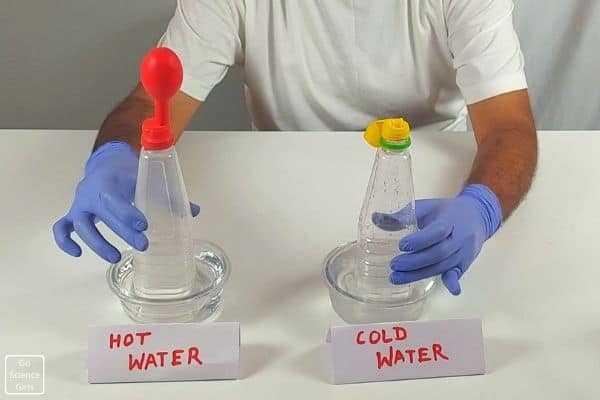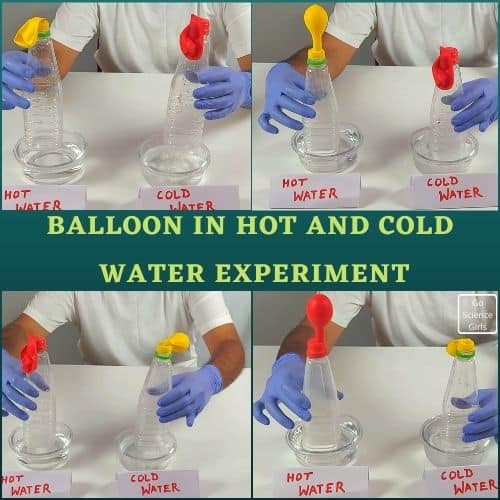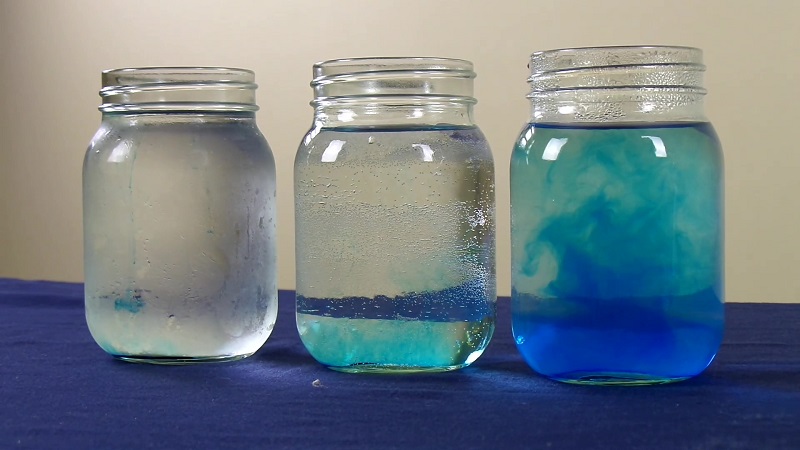Describe an Experiment Using Only Hot and Cold Water
Drop a few drops of food coloring in each cup. Fill one pan with ice and cold water.

Balloon In Hot And Cold Water Experiment
Describe an experiment using only hot and cold water that would allow you to verify that the heat capacity of a coffee-cup calorimeter is about 10 eqtimes 10-1 eq Jeqo eqC.

. Each molecule has one oxygen and two. Using the food coloring and a thermal infrared camera you can re. When the cold water is on the bottom the hot water doesnt have to rise--its already on top.
However under some conditions the. Turn the CBL into a thermometer by selecting MODE. In one glass pour the cold water and in the other hot water.
Describe an experiment using only hot and cold water that would allow you to verify that the heat capacity of your coffee-cup calorimeter is about 10 times 101 Jdegree C. Do not put any ice in the cold water cup. For cold water fill the jar and put it in the fridge for an hour or two.
The cold blue water stays on. Take 2 transparent glasses and fill them with the water. Add 4 -5 drops of food coloring for each color you want to add.
Step 1 Begin by preparing three identical jars of water. Fill your jar or vase 34 full with water. How to do the experiment.
Up to 64 cash back Pour the hot water into the big glass jar and cover it with a dinner plate. Up to 24 cash back Describe an experiment using only hot and cold water that would enable you to verify that the heat capacity of your coffee-cup calorimeter is about 10 x 101 JOC. Fill Cup 1 with 100 ml of cold water about 10 C and Cup 2 with 150 ml of warm water about 50 C.
If you were to have 2 cups of water one of hot water and one of cold water with equal volumes the cold water would have more molecules. Describe in detail an experiment using only hot and cold water that would enable you to verify that the heat capacity of your coffee cup calorimeter is about 1010 jC. Be specific about the procedure you would follow and the calculations you would need to perform.
Turn ON the CBL unit and plug the TI temperature probe into channel one. - Warm water NOTE - be careful not to make the water too hot - Cold water with a few ice cubes in it - Medium temperature water. It will rain inside the jar.
Describe an experiment using only hot and cold water that would allow you to verify that the heat capacity of your coffee-cup calorimeter is about 10 x 101 JC. For the room temperature water fill. As we mentioned near-boiling water for hot and regular temperature water from the pipe will be good to demonstrate the diffusion.
Describe an experiment using only hot and cold water that would enable you to. The temperature of the cold tap water is 220C and the temperature of the hot tap water is 550C. When you heat up water the water molecules start moving around faster and faster.
2 - Put one hand into the warm water and one in the iced water for one minute. STEP2 - Pour some hot water into one of your glasses and exactly the same amount of cold. Describe in detail an experiment using only hot and cold water that would enable you to verify that the heat capacity of your coffee-cup calorimeter is about 10 x 10 JC.
So hot water takes up more space than cold water. A biology experiment requires the preparation of a water bath at 370C body temperature. A little more oil will show the difference in density slightly better for kids.
Be Be specific about the procedure you would follow and the calculations you would need to. Describe an experiment using only hot and cold water that would allow you to verify that the heat capacity of your coffee-cup calorimeter is about 10 x 101. You do not need a lot like we used you can even just use about 4 tablespoons of oil for a thin layer.
STEP1 - The setup for this experiment couldnt be much simpler. So hot water is less dense than cold water. Describe an experiment using only hot and cold water that would enable you to verify that the heat.
All we need is two identical cups and some hot and cold water. Let the plate-covered jar sit there for a minute or two then dump a tray of ice cubes on the plate. Describe an experiment using only hot and cold water that would allow you to verify that the heat capacity of your coffee-cup calorimeter is about 10 x 101 JC.
Of course if the hot water had started at 999 C and the cold water at 001 C then clearly under those circumstances the initially cooler water would have frozen first. Add oil into a bowl. The amount of space something takes up is called volume.
1 Jar of cold water 1 Jar of hot water 1 Plastic card 1 Spoon 1 Large dish or a baking pan Red and blue food coloring. Describe an experiment using only hot and cold water that would enable you to verify that the heat capacity of your coffee-cup calorimeter is about 10x 10 1Jdegrees C. 1 - Fill one bowl with warm water one with iced water and one with medium water.
Water Temperature Science Experiment Instructions. Hot Cold Water Science Experiment HooplaKidzLab. Hot And Cold Water Science Experiment.
Why doesnt the water mix when the hot water is on top. With two matching jars red and blue food coloring some hot and cold water an index card and a dish or baking pan you can observe how the different densities of hot and cold water behave. Fill one jar with cold water one jar with room temperature water and one jar with hot water.
3-4 drops are enough and you should not put too much food color. Instructions for a fun experiment to teach the difference between the density of hot water and the density of cold wat. Place the bottle in the pan with the hot water.
If a student starts with 700 g of. When you put the two together with the hot water on the bottom the hot water rises to the top mixing with the cold water along the way and creating purple water. For safety its best to use plastic cups as water gets a little bigger when it freezes which could cause a glass to shatter if you didnt keep an eye on it.
The only difference between the two was that the water in one was at a higher uniform temperature than the water in the other. This experiment by HooplaKidzLab demonstrates how the more dense cold water sinks those molecules are. Mar 26 2021 0826 AM.
In this experiment you can visualize the difference in density between hot and cold water. The display should be reading a temperature in Celsius. Hot and cold water are made of the same type of molecules.
The ice on the plate will make the plate very cold which causes the warm air in the jar to condense and form water droplets.

How To Do The Hot And Cold Water Density Experiment Amazing Science Experiments Science Experiments Ocean Science Experiments

Balloon In Hot And Cold Water Experiment

Water Temperature Science Experiment Science Experiments For Preschoolers Science Experiments Kids Water Temperature Experiment

No comments for "Describe an Experiment Using Only Hot and Cold Water"
Post a Comment